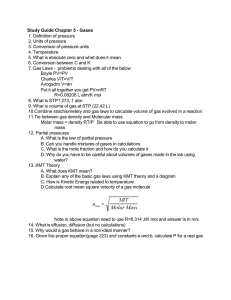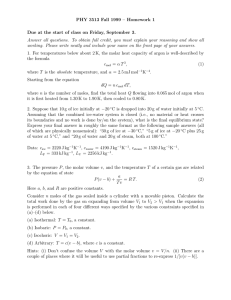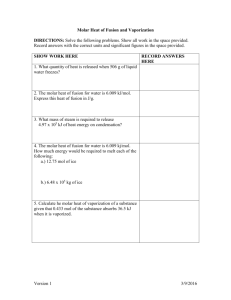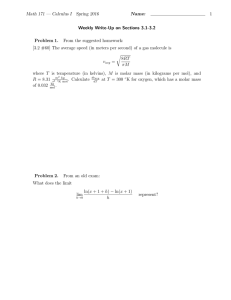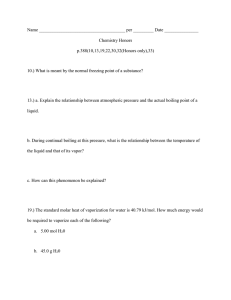Chemistry 331 Lecture 6 Ideal Gas Behavior NC State
advertisement
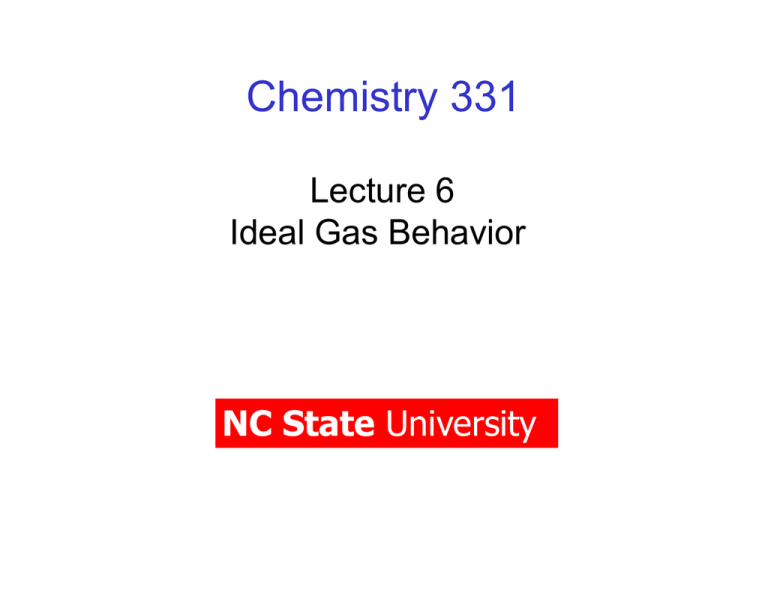
Chemistry 331 Lecture 6 Ideal Gas Behavior NC State University Macroscopic p variables P, T Pressure is a force per unit area (P= F/A) The force arises from the change in momentum as particles hit an object and change direction. Temperature derives from molecular i molar l motion (3/2RT = 1/2M<u2>) M is mass Greater average g velocity y results in a higher temperature. u is the velocity Mass and molar mass We can multiply the equation: 3 RT = 1 M <u 2> 2 2 by the number of moles, n, to obtain: 3 nRT = 1 nM <u 2> 2 2 If m is the mass and M is the molar of a particle then we can also write: p nM = Nm (N is the number of particles) Mass and molar mass In other words nNA = N where NA is Avagadro’s Avagadro s number number. 3 nRT = 1 Nm <u 2> 2 2 Kinetic Model of Gases Assumptions: 1. A gas consists of molecules that move randomly. 2 Th 2. The size i off th the molecules l l iis negligible. li ibl 3. There are no interactions between the gas molecules. Because there are such large numbers of gas molecules in any system we will interested in average quantities. We have written average with an angle bracket. For example, the average speed is: s 12 + s 22 + s 32 + ... + s N2 <u > = c = N 2 2 c= s 1 + s 2 + s 3 + ... + s N N We use s for speed and d c ffor mean speed. d Velocity and Speed When we considered the derivation of pressure using a kinetic model we used the fact that the gas exchanges momentum with the wall of the container. Therefore, the vector (directional) quantity velocity was appropriate. However, in the energy expression the velocity enters as the square and so the sign of the velocity does not matter. In essence it is the average speed that is relevant for the energy Another way to say this is the energy is a scalar energy. scalar. E = 1 m<u 2> = 1 mv 2 = 1 mc 2 2 2 2 p = mu = mv All of these notations mean the same thing. The root-mean-square q speed p The ideal gas equation of state is consistent with an p of temperature p as p proportional p to the kinetic interpretation energy of a gas. 1 M u 2 = RT 3 If we solve for <u2> we have the mean-square speed. u 2 = 3RT M If we take the square root of both sides we have the r.m.s. speed. u 2 1/2 = 3RT M Example The r.m.s. speed of oxygen at 25 oC (298 K) is 482 m/s. Note: M is converted to kg/mol! u 2 1/2 3 8.31 J/mol–K 298 K = 0.032 kg/mol g = 481.8 m / s The Maxwell Distribution Not all molecules have the same speed. Maxwell assumed that the distribution of speeds was Gaussian Gaussian. F(s) = 4 M 2RT 3/2 2 Ms s exp – RT 2 As temperature p increases the r.m.s. speed p increases and the width of the distribution increases. Moreover, the fucntions is a normalized distribution. This just means that the integral over the distribution function is equal to 1 1. F(s)ds = 1 0 See the MAPLE worksheets for examples. Units of Pressure Force has units of Newtons F = ma (kg m/s2) Pressure has units of Newtons/meter2 P= F/A = (kg m/s2/m2 = kg/s2/m) These units are also called Pascals (Pa). 1 bar = 105 Pa = 105 N/m2. 1 atm = 1.01325 x 105 Pa Units of Energy gy Energy has units of Joules 1 J = 1 Nm N Work and energy have the same units. Work is defined as the result of a force g through g a distance. acting We can also define chemical energy in terms of the energy per mole mole. 1 kJ/mol 1 kcal/mol k l/ l = 4.184 4 184 kJ/mol kJ/ l Thermal Energy gy Thermal energy can be defined as RT. I magnitude Its i d d depends d on temperature. R = 8.31 J/mol-K or 1.98 cal/mol-K At 298 K K, RT = 2476 J/mol (2.476 (2 476 kJ/mol) Thi iis th This the molar l energy available il bl tto a system at 298 K. Thermal Energy gy Thermal energy can also be expressed on a per molecule basis basis. The molecular equivalent of R is the Boltzmann constant, k. R = NAk NA = 6.022 x 1023 molecules/mol At 298 K, RT = 2476 J/mol (2.476 kJ/mol) RT = 4.11 x 10-21 J Extensive and Intensive Variables Extensive variables are proportional to the size of the system. Intensive variables do not depend on the size of the system. system Extensive E t i variables: i bl volume, l mass, energy Intensive variables: pressure, temperature, density Equation of state relates P, V and T The ideal gas equation of state is PV = nRT RT An equation of state relates macroscopic properties which result from the average behavior of a large number of particles. P Macroscopic Microscopic Microsopic p view of momentum c ux b area = bc a A particle with velocity ux strikes a wall. The momentum of the particle changes from mux to –mux. The momentum change is p = 2mux. Transit time c ux b area = bc a The time between collision is t = 2a/ux. Transit time c Round trip distance is 2a area = bc ux b a The time between collision is t = 2a/ux. velocityy = distance/time. time = distance/velocity. The p pressure on the wall force = rate of change of momentum p 2mu x mu x2 F= = = a t 2a/u a/u x The pressure is the force per unit area. The area is A = bc and the volume of the box is V = abc 2 2 mu mu x x F P= = = V bc abc Average g p properties p Pressure does not result from a single particle ti l striking t iki th the wallll b butt ffrom many particles. Thus, the velocity is the average velocity l it titimes th the number b off particles. ti l Nm u 2x P= V PV = Nm 2 ux Average g p properties p There are three dimensions so the velocity along the xx-direction direction is 1/3 the total total. 1 2 = u 3 u 2x Nm u2 PV = 3 From the kinetic theory of gases 1 Nm u 2 = 3 nRT 2 2 Putting g the results together g When we combine of microscopic view of pressure with ith th the ki kinetic ti th theory off gases result we find the ideal gas law. PV = nRT This approach applies to a monatomic gas like neon or argon. What about internal motions of molecules? RT is a natural energy gy scale We can rewrite the ideal gas law in terms off the th molar l volume l V = V/n The ideal gas law has the form PV = RT The molar volume at standard T and P V = RT = P 8.31 J/mol–K 298 K 1 013 10 5 N/m 2 1.013 = 0.0244 m 3 = 24.4 L Microscopic p variables Monatomic gases: translation Pressure and temperature can be described solely in terms of the ballistic motion of the gas. Diatomic gases: translation, translation vibration, vibration rotation Center of mass Quantized energy gy levels The constant h, known as Planck’s constant gives the scale for quantized energy levels levels. h = 6.626 x 10-34 J Translation – particle in a box Vibration – harmonic oscillator Rotation – rigid rotator The energy levels for each of these is obtained by solution of the Schrödinger equation. The energy gy level spacing p g The constant h, known as Planck’s constant gives the scale for quantized energy levels levels. h = 6.626 x 10-34 J Motion # Formula Vibration v (v + 1/2)h Rotation J [h2/82I]J(J+1) Translation n [h2/8ma2]n2 kJ/mol 1 – 20 10-3 – 1 10-11 We will see how to obtain these in the second half of the course. Levels are thermally y ppopulated p E RT Vib ti Vibration R t ti Rotation T Translation l ti Key points regarding the microscopic view Translational energy levels are so densely spaced that these can be treated using classical methods. We can treat particles as ideal even though they have vibrations and rotations. The dynamics of the gas are not affected. We will see that the heat capacity of the gas is affected by the “internal” internal degrees of freedom. Key points regarding the microscopic view The kinetic energy of a large number of individual particles is proportional to the temperature of the system. As the system heats up we can picture the molecules moving more rapidly. Pressure results from the net momentum transfer between the particles and wall of the container. Pressure of a dense fluid For a dense fluid (or a liquid) such as water we can think thi k off the th pressure arising i i ffrom the weight of the column of fluid above the point i t where h th the measurementt is i made. d The force is due to the mass of water m (kg) accelerated by gravity (g = 9.8 m/s2). P= F A mg mgh mgh = = = = gh A Ah V where is the density = m/V. The dependence of atomspheric pressure on altitude We can think W thi k off the th atmosphere t h is i a fluid, fl id but it is not dense. Moreover, unlike water the density of the atmosphere decreases with altitude. Thus, at high elevations both the pressure and the density are decreased. To obtain the dependence of pressure on height h above the earth’s surface we use the ideal gas law to define the density of an ideal gas. The dependence of atomspheric pressure on altitude The d Th density it off an id ideall gas iis: = m/V = nM/V = MP/RT The dependence of pressure on elevation is: MPg dP = – g dh = – dh RT We need to collect variables of integration g on the same side of the equation. dP = – Mg dh P RT The barometric p pressure formula Then we integrate (assuming P0=1 at h=0): P dP = – Mg RT P0 = 1 P Mgh P ln =– P0 RT h dh 0 Mgh Mgh P = P0exp – or P = exp – atm RT RT Isotherms We can plot the pressure as a function of the volume as shown below. Each of the curves on the plot has a constant temperature. Partial pressure For any gas in a mixture of gases the partial pressure is defined as: p Pj = xjP where xj is the mole fraction of component j and P is the total pressure. Th mole The l ffraction ti iis d defined fi d as: nj xj = ni i The molar volume We can rewrite the ideal gas law in terms off the th molar l volume l V Vm = n The ideal gas law has the form PVm = RT Th molar The l volume l att standard t d d T and dP Vm = RT = P 8.31 J/mol–K 298 K 1.013 10 N/m 2 5 = 0.0244 0 0244 m 3 = 24.4 24 4 L The Compression p Factor One way to represent the relationship between ideal and real gases is to plot the deviation from ideality as the gas is compressed (i.e. as the pressure is increased). The compression factor is defined as: Molar volume of gas Compression Factor = Molar volume of perfect gas Written in symbols this becomes: Z= Vm perfect Vm = PVm RT Note that perfect gases are also called ideal gases. Imperfect gases are sometimes called real gases. The Compression p Factor A plot of the compression factor reveals that many gases exhibit Z < 1 for low pressure. This indicates that attractive forces dominate under these conditions. As the pressure increases Z crosses 1 and eventually becomes positive for all gases gases. This indicates that the finite molecular volume leads to repulsions between closely packed gas molecules. These repulsions are not including the ideal gas model. Attractive Region Repulsive Region The Virial Expansion p One way to represent the deviation of a gas from ideal (or perfect) behavior is to expand the compression factor in powers of the inverse molar volume. Such an expansion is known as a virial expansion. Z = 1 + B + C2 + ... Vm Vm The coefficients B, C etc. are known as virial coefficients. For example, B is the second virial coefficient. Virial coefficients depend on temperature temperature. From the preceding considerations we see the B < 0 for ammonia, ethene, methane and B > 0 for hydrogen. The Virial Equation q of State We write Z in complete form as: PVm = 1 + B + C2 + ... Vm Vm RT An then solve for the pressure: P = RT 1 + B + C2 + ... Vm Vm Vm This expression is known as the virial equation of state state. Note that if B, C etc. are all equal to zero this is just the ideal gas law. However, if these are not zero then this equation contains corrections to ideal behavior. Relating the microscopic to the macroscopic Real gases differ from ideal gases in two ways. First they have a real size (extent). The excluded volume results in a repulsion between particles and larger pressure than the corresponding ideal gas (positive contribution to compressibility). S Secondly, dl th they h have attractive tt ti fforces between b t molecules. l l These are dispersive forces that arise from a potential energy due to induced-dipole induced-dipole interactions. We can relate the potential energy of a particle to the terms in the virial expansion or other equation of state. While we will not do this using math in this course we will consider the graphical form of the potential energy functions. Hard Sphere Potential u(r) = u(r) =0 r< r> u(r) A hard sphere potential is the easiest potential to parameterize. The hard sphere diameter corresponds to the interatomic spacing i iin a closest l t packed k d geometry t such h as th thatt shown h for the noble gas argon. The diameter can be estimated Ar Ar Ar Ar Ar Ar Ar Ar from the density of argon in the solid state. The hard sphere Ar Ar Ar Ar potential is widely used because A Ar Ar A Ar A Ar A of its simplicity. r The Hard Sphere Equation of State As a first correction to the ideal gas law we can consider the fact that a gas has finite extent. Thus, as we begin to decrease the volume available to the gas the pressure increases more than we would expect due to the repulsions between the spheres of finite molar volume, b, of the spheres. nRT P= V – nb Gas molecule of volume B The Hard Sphere Model Low density: These are ideal gas conditions The Hard Sphere Model Increasing density: the volume is V b is the molar volume of the spheres spheres. The Hard Sphere Model Increasing density The Hard Sphere Model Increasing density The Hard Sphere Model High density: At sufficiently high density the gas becomes a high density fluid or a liquid. The Hard Sphere Model Limiting density: at this density the hard spheres have condensed into an ordered lattice. They are a solid. The “gas” cannot be compressed further further. If we think about the density in each of these cases we can see that it increases to a maximum value. Lennard-Jones Potential Function The Lennard-Jones potential is a most commonly used potential function for non-bonding interactions in atomistic computer t simulations. i l ti 12 6 LJ V (R) = 4 – R R The potential has a long long-range range attractive tail –1/r 1/r6, and negative well depth , and a steeply rising repulsive wall at R = . Typically the parameter is related to the hard sphere diameter of the molecule. For a monoatomic condensed phase is determined either from the solid state or from an estimate of the packing in dense liquids. The well depth e is related to the heat of vaporization of a monatomic fluid. For example, liquid argon boils at ~120K at 1 atm. atm Thus Thus, ~ kT or 1 1.38x10 38x10-23 J/K(120 K) = 1 1.65x10 65x10-21 J. J This also corresponds to 1.03 kJ/mol. Graphical Representation L-J Potential The L-J potential function has a steep rise when r < . This is the repulsive term in the potential that arises from close l contacts t t between b t molecules. l l Th The minimum i i iis ffound d for Rmin = 21/6 . The well depth is in units of energy. Rmin The van der Waal’s Equation of State The microscopic terms and in the L-J potential can be related to the a and b parameters in the van der Waal’s equation of state below below. 2 n nRT P= – a 2 V – nb V The significance of b is the same as for the hard sphere potential potential. The parameter a is related to the attractive force between molecules It tends to reduce the pressure molecules. compared to an ideal gas. The van der Waal’s Equation of State i tterms off molar in l volume l Recall that Vm = V/n so that the vdW equation of state becomes: P = RT – a2 Vm – b Vm We can plot this function for a variety of different temperatures. As we saw for the ideal gas these are isotherms. isotherms At sufficiently high temperature the isotherms of the vdW equation of state resemble those of the ideal gas. The argon phase diagram For argon Tc = 150.8 K Pc = 48.7 bar = 4934.5 Pa Vc = 74.9 cm3/mol Critical Point Significance of the critical point Note that the vdW isotherms look very different from those of the ideal gas below the critical point. Below the critical point there are two possible phases, liquid and gas. The liquid phase is found at small molar volumes. The gas phase is observed at larger molar volumes. The shape of the isotherms is not physically reasonable in the transition region between the phases. Note that the implication is that there is a sudden change in volume for the phase transition from liquid to gas. View of the liquid region off the th argon phase h diagram di Liquid Phase Equilibrium Region Critical Parameters The critical parameters can be derived in terms of the vdW a and b parameters as well as the gas constant R. The derivation can use calculus since q of the derivative of the vdW equation state is zero at the critical point. Given that this is also an inflection point the second derivative is also zero. a 2 27b 8a Tc = 27Rb Vc = 3b Pc =
